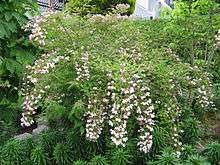Linnaea amabilis
Linnaea amabilis, also known under the synonym Kolkwitzia amabilis /kɒlˈkwɪtsiə əˈmæbɪlɪs/[1] and the English name beauty bush, is a species of flowering plant in the family Caprifoliaceae. It is a deciduous shrub grown as an ornamental plant. In China, where it originated, the plant is wei shi shu[2] (蝟实).[3]
- Not to be confused with the beautyberry bush, Callicarpa.
| Beauty bush | |
|---|---|
 | |
| Scientific classification | |
| Kingdom: | Plantae |
| Clade: | Tracheophytes |
| Clade: | Angiosperms |
| Clade: | Eudicots |
| Clade: | Asterids |
| Order: | Dipsacales |
| Family: | Caprifoliaceae |
| Subfamily: | Linnaeoideae |
| Genus: | Linnaea |
| Species: | L. amabilis |
| Binomial name | |
| Linnaea amabilis Graebn. Christenh. | |
Description

The plant is an arching, spreading shrub, with light brown flaky bark and graceful arching branches, which can grow higher than 8 ft (2.4 m) tall. It is usually as wide as it is tall. The plant blooms in late spring. Its light pink flowers, dark pink in the bud, are about one-inch long and bell-shaped ("tubular campanulate"); they grow in pairs, as with all Caprifoliaceae, and form showy, numerous sprays along ripened wood. Its leaves are opposite, simple, and ovate, from 0.5 to 3 in (1.3 to 7.6 cm) long, entire or with a few sparse shallow teeth. Its fruit is a hairy, ovoid capsule approximately 0.25 in (0.6 cm) inches long.
Taxonomy
The species was first described by Paul Graebner and placed in his new genus, Kolkwitzia, whose name honours Richard Kolkwitz, a professor of botany in Berlin.[4] The specific epithet amabilis means "lovely".[5] In 2013, it was suggested that Kolkwitzia, along with the genera Abelia, Diabelia, Dipelta and Vesalea, be merged into an expanded genus Linnaea.[6]
History
The beauty bush originates in Central China, where it has been discovered for science twice, once by the Jesuit missionary Giuseppe Giraldi in Shensi and then in western Hubei province, by E.H. 'Chinese' Wilson[7] who was collecting for Veitch Nurseries and who introduced it into horticulture.[8] Wilson sent plant material to his sponsors Veitch Nurseries in Exeter, in 1901, where the shrub flowered for the first time in 1910. The shrub became very popular in the eastern United States following World War I – almost a defining shrub in American gardens made between the World Wars. It is very rare and threatened in the wild.
Numerous cultivars have been developed for garden use. Under the synonym Kolkwitzia amabilis the cultivar ‘Pink Cloud’ has gained the Royal Horticultural Society’s Award of Garden Merit.[9] [10]
Pruning
Opinions differ concerning how much pruning the shrub needs. The University of Missouri Horticulture Department suggests minimal intervention, so long as the plant has enough room to develop, up to a maximum height of 15 ft (4.6 m) and a potential "spread" of 8 ft (2.4 m).[11] Others suggest more active intervention to encourage development of new flowering branches and buds, with decisive pruning immediately after flowering.[12]
References
- Sunset Western Garden Book, 1995:606–607
- https://www.shutterstock.com/search/wei+shi+shu
- "4. KOLKWITZIA Graebner, Bot. Jahrb. Syst. 29: 593. 1901" (PDF). Harvard University Herbaria.
- Albert, Render (1917). L.H. Bailey (ed.). The Standard Cyclopedia of Horticulture. London: MacMillan & Co., Ltd. pp. 1757.
Kolkwitzia amabilis.
- Harrison, Lorraine (2012). RHS Latin for gardeners. United Kingdom: Mitchell Beazley. p. 224. ISBN 9781845337315.
- Christenhusz, Maarten J.M. (2013). "Twins are not alone: a recircumscription of Linnaea (Caprifoliaceae)". Phytotaxa. 125 (1): 25–32. doi:10.11646/phytotaxa.125.1.4.
- St Andrews Botanical Garden: Kolkwitzia amabilis Archived 2008-06-26 at the Wayback Machine
- Alice M. Coats, Garden Shrubs and Their Histories (1964) 1992, s.v. "Kolkwitzia"
- "'Kolkwitzia amabilis 'Pink Cloud'". www.rhs.org. RHS. Retrieved 3 September 2019.
- "AGM Plants - Ornamental" (PDF). www.rhs.org. Royal Horticultural Society. July 2017. p. 57. Retrieved 17 March 2018.
- "Selecting Landscape Plants: Deciduous Shrubs" (PDF). Department of Horticulture, University of Missouri.
- "Pruning Kolkwitzia amabilis - How/when to prune Beauty Bush".
External links
- Qiner Yang and Sven Landrein, "Kolkwitzia amabilis Graebner, Bot. Jahrb. Syst. 29: 593. 1901", Flora of China
| Wikimedia Commons has media related to Linnaea amabilis. |